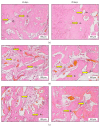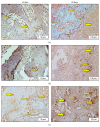Impact of ellagic acid in bone formation after tooth extraction: an experimental study on diabetic rats
- PMID: 25485304
- PMCID: PMC4251085
- DOI: 10.1155/2014/908098
Impact of ellagic acid in bone formation after tooth extraction: an experimental study on diabetic rats
Abstract
Objectives: To estimate the impact of ellagic acid (EA) towards healing tooth socket in diabetic animals, after tooth extraction.
Methods: Twenty-four Sprague Dawley male rats weighing 250-300 g were selected for this study. All animals were intraperitoneally injected with 45 mg/kg (b.w.) of freshly prepared streptozotocin (STZ), to induce diabetic mellitus. Then, the animals were anesthetized, and the upper left central incisor was extracted and the whole extracted sockets were filled with Rosuvastatin (RSV). The rats were separated into three groups, comprising 8 rats each. The first group was considered as normal control group and orally treated with normal saline. The second group was regarded as diabetic control group and orally treated with normal saline, whereas the third group comprised diabetic rats, administrated with EA (50 mg/kg) orally. The maxilla tissue stained by eosin and hematoxylin (H&E) was used for histological examinations and immunohistochemical technique. Fibroblast growth factor (FGF-2) and alkaline phosphatase (ALP) were used to evaluate the healing process in the extracted tooth socket by immunohistochemistry test.
Results: The reactions of immunohistochemistry for FGF-2 and ALP presented stronger expression, predominantly in EA treated diabetic rat, than the untreated diabetic rat.
Conclusion: These findings suggest that the administration of EA combined with RSV may have accelerated the healing process of the tooth socket of diabetic rats, after tooth extraction.
Figures






References
-
- Mellado-Valero A., Ferrer García J. C., Herrera Ballester A., Labaig Rueda C. Effects of diabetes on the osseointegration of dental implants. Medicina Oral, Patología Oral y Cirugía Bucal. 2007;12(1):E38–E43. - PubMed
Publication types
MeSH terms
Substances
LinkOut - more resources
Full Text Sources
Other Literature Sources

